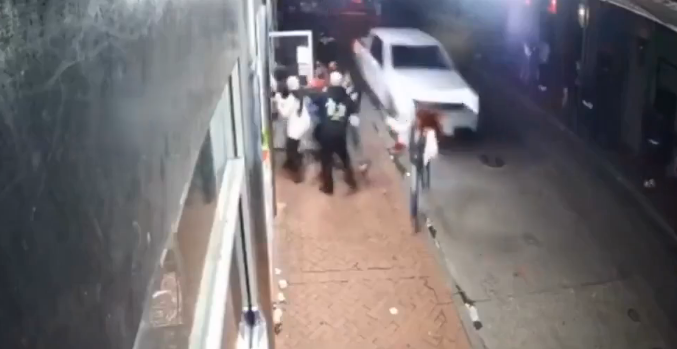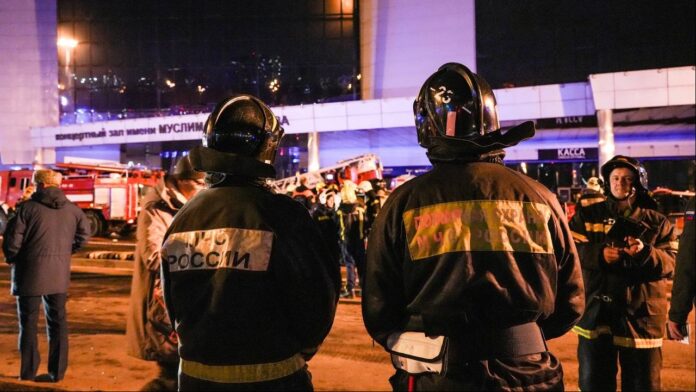By Andy Oppenheimer
The terrorist attacks of 2024 appeared to be a deadly mix of modus operandi and motivations by varied miscreants, writes Andy Oppenheimer. The usual violent religious extremists and the political far-right were in evidence, while the lone wolf also made a lethal reappearance.
At 3.15am on New Year’s Day 2025, a 42-year-old U.S. citizen, Shamsud-Din Jabbar, drove a pick-up truck at 70mph (112kmh) into a crowd on Bourbon Street in New Orleans, killing 14 and injuring 35. After exiting the vehicle, he fired at local police who shot him dead.
His affiliation became clear when an ISIS flag was retrieved from his vehicle. After suspecting he had accomplices – which many apparent lone wolf attacks have turned out to involve – the FBI later ruled that he had acted alone.
His modus operandi was intentionally varied; a marauding terrorist attack using a vehicle, as well as firearms and a potential IED found in the truck. Other viable IEDs had been planted in street coolers nearby and were rendered safe following the attack. Explosives precursors were found at a rented home that Jabbar earlier tried to burn down.
“Rare” Explosive
Of interest were additional FBI field tests indicating that Jabbar used what they termed a very rare explosive compound, R-Salt, which is actually pure Research Department Explosive, or RDX. The authorities said this had never been used in a U.S. or European terrorist incident, however RDX is a stable component of Semtex and was widely used by the Provisional IRA in its 30-year bombing campaign.
Apart from explosives, cars, vans, and the legally held firearms ubiquitous in the U.S. are among totally legal instruments that can be used for terrorism, thus making the modus operandi for these acts more varied and much harder to pre-empt.

The Magdeburg Attack
Only days before the New Orleans attack, on December 20 five people were killed and 299 injured in a marauding terrorist attack on a Christmas market in Magdeburg, Germany, when a rented SUV was rammed into the crowd. The driver, Taleb al-Abdulmohsen, described as a 52-year-old Saudi-born psychiatrist, was arrested and later charged with counts of murder, attempted murder, and dangerous bodily harm, but at the time of writing, not terrorism. A sixth victim died in early January. Many hundreds more were traumatized by the attack.
Markets have become a common terror target. In August a 26-year-old Syrian-born man with suspected ISIS affiliation was arrested after three people were killed in a stabbing rampage in a market in Solingen, Germany. In the beginning, at least, the suspect was not previously known by the authorities to have extremist associations.
The Magdeburg suspect’s apparent motivation is, however, still to be clarified. Instead of being a violent jihadist as initially assumed by many, preliminary information on his background and activities indicates the opposite. It has been said that in many online posts he expressed anti-Islam views and supported far-right conspiracy narratives on the “Islamization” of Europe.
From 2006 he resided in the nearby town of Bernburg and was granted asylum in 2016. He ran a website aiming to help other former Muslims flee persecution. German Interior Minister Nancy Faeser said: “The perpetrator does not fit into any previous categorization.”
However, it later emerged that he had in fact been known to German authorities. In 2015 he allegedly claimed online that he could acquire a firearm to exact revenge on judges in his previous cases.
Dagestan and Moscow
On June 24, 2024, coordinated gun attacks on churches and a synagogue in two cities in the Russian republic of Dagestan killed 20, including 15 police, and injured 46. Five gunmen were also killed. The twin attacks in Derbent and Makhachkala on the Orthodox festival of Pentecost were claimed by an Islamist group, but Russian authorities blamed it on Ukraine and the West to distract from internal strife that could undermine the legitimacy of Vladimir Putin’s rule.
They also blamed Ukraine – as usual, without evidence – for the attack waged by four Islamic State gunmen who fired on the Crocus City Hall venue near Moscow during a rock concert attended by 6,200 people on March 22, 2024. They then set the hall on fire with petrol bombs. Some 147 were killed and more than 140 injured.
Both incidents were a bleak reminder of the Chechen terror campaign from 2007 to 2017, when the jihadist Caucasus Emirate, and later the Islamic Emirate of the Caucasus, staged attacks in Dagestan and the neighboring Russian republics of Chechnya, Ingushetia, and Kabardino-Balkaria.

Lone Wolves Return
The Magdeburg attack marked an alarming development insofar as an individual could be radicalized by far-right ideas after settling in Germany. It may show that examining the motivations behind terrorist attacks and the ability to pre-empt them will have to factor in many other possibilities beyond previously identified categories. Nevertheless, it is believed he acted alone, marking a second “lone-wolf” attack within a month.
The recent New Orleans attack also demonstrated a higher level of lone wolf preparation and modus operandi, albeit the protagonist having been a U.S. Army veteran with possible IED-making skills.
Southport – and Ricin
On January 23, 2025, Axel Rudakubana was given a 52-year minimum life sentence for the “ferocious” and “sadistic” murders of three schoolgirls and the attempted murder of ten other people at a dance class in Southport, England, on July 29, 2024.
It was not designated a terrorist attack, despite the perpetrator having possession of a PDF file of Military Studies in the Jihad Against the Tyrants: The Al-Qaeda Training Manual and other online material on extreme violence and genocides. Police believed the stabbing methods may have been influenced by the manual, and the sentencing judge likened its seriousness to an act of terrorism.
Of CBRN interest was that the biological toxin ricin was discovered at his home in the form of pulp contained in a plastic box. Only 0.5mg can be fatal to adults. Items discovered included funnels, flasks, safety goggles, and a pestle and mortar, which contained ricin residue. The materials had been bought online two years before the attack, and instructions for ricin making could have been obtained from the illegal Al-Qaeda manual.

Disturbing Trends
Days before Rudakubana was sentenced, U.K. Prime Minister Sir Keir Starmer stated that the Southport crimes were a “new form of terrorism committed by loners and misfits”, and that the perpetrators were sometimes inspired by traditional terrorist groups but fixated on “extreme violence… for its own sake.”
The Southport case highlighted the growing threat by young men obsessed with violence against women and girls. It also showed a possible need to reclassify or widen the definition of terrorism, which is assumed as violence inspired by a specific political, racial, or religious ideology and usually as part of, or inspired by, a specific group intending to exact political change through violence.
According to Hannah Rose of the Institute of Strategic Dialogue: “We’re also seeing the mainstreaming of ideas such as extreme misogyny online, or school shooter fandoms. Some of this is aestheticized online with graphics or fast music, presented as a computer game, and one result is that people without an ideology become motivated to carry out acts of extreme harm.”

Neo-Nazis
In June 2024, Mason Reynolds, a 19-year-old with neo-Nazi views from Brighton, England, was jailed for nine years for planning to carry out a suicide bomb attack on a synagogue in nearby Hove.
Reynolds had previous convictions for possession of an article for the preparation of a terrorist act and admitted ten offences relating to terrorist publications and material. He possessed explosives and gun-making manuals, as well as a Google map and satellite image of the synagogue featuring entry points and points to attack. The Head of Counter Terrorism Policing South East Detective Chief Superintendent Olly Wright said: “This is another case involving a young person following a toxic extreme right-wing terrorist and antisemitic path.”
The U.K.’s Independent Reviewer of State Threats Legislation and Independent Reviewer of Terrorism Legislation, Jonathan Hall KC, told LBC Radio following their investigation that he was more worried about lone actors – especially from the far-right – than groups.
The underlying trends that potentially lead to terrorism have been fuelled by a startling increase of online propaganda and material that can assist acts of terrorism. In April 2024, the U.K. government banned an online neo-fascist group known as Terrorgram.
More young people, mainly males, are subscribing to neo-Nazi views. In October 2024, MI5 Director Ken McCallum said: “13% of all those being investigated by MI5 for involvement in U.K. terrorism are under 18.” This constitutes a threefold increase in the past three years.
Axel Rudakubana had been referred to the U.K. government’s counter-terrorism Prevent program once in 2019 and in twice in 2021, aged 13 and 14. One referral involved his potential interest in school massacres. He was able to buy a 20cm kitchen knife online at age 17, a revelation that has spurred the ruling Labour Party to tighten the relevant laws.
Availability of Weapons
In January, an investigation by LBC Radio revealed that far-right channels on the social media platform Telegram were sharing IED and gun-making guides, recipes for homemade napalm and firearms, and detailed information about Islamic centers. It took LBC 45 minutes to find this material, and an EOD veteran confirmed that the information on IEDs was valid.
The LBC investigation followed the sentencing of a taxi driver whose Telegram channel, Southport Wake Up, was described as a “catalyst” for the riots that broke out following the Southport stabbings.
Combined with online information on weapons and modus operandi, individuals may enter the murky and dangerous world of extremism, and consequently, terrorism. These trends accompany the old menaces of international terrorist groups like ISIS and Al-Qaeda, thus comprising a deadly mix of threats facing counter-terrorism authorities in the coming years.
Andy Oppenheimer AIExpE MIABTI is an independent CBRNE and counter-terrorism analyst, former editor of CBNW Journal and Jane’s NBC Defence, and author of IRA: The Bombs and the Bullets (2008). He became Editor of the Felix Fund Bomb Disposal Charity’s Newsletter in January 2025.





